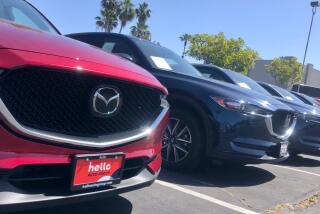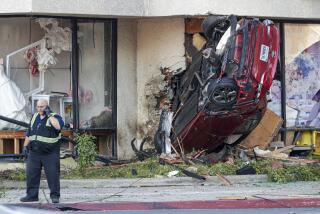THE GOODS : Sitting Pretty
- Share via
In its steamy beginnings, auto safety meant a city speed limit of 2 m.p.h. with a signalman carrying a red flag ahead of your 1865 Roper.
Last year, GM crashed its 10,000th car since testing began in 1936. Ford owns 100 crash dummies costing up to $100,000 apiece and able to measure 85 impact variables--including a female dumm2032165743 To sell their cars in the United States, even Rolls-Royce and Ferrari must meet federal standards and crash their six-figure status symbols into fixed barriers at 30 m.p.h.
And safety equipment forms an endless list. Disc brakes. Padded dashboards. Steel-belted, run-flat, water-deflecting tires. Shock-absorbing steering wheels. Crumple zones. Some devices are 1986359929 Among the most popular:
Air Bags: Driver deaths in frontal crashes are about 24% lower in cars with air bags. By 1998, federal regulations will require new cars to have this protection for driver and passenger.
Triggered by sensors responding to a 12 m.p.h. impact, a fabric bag fills with gas in 1/20th of a second. Once an occupant is cushioned, the bag deflates and forward vision is restored.
Efficient and reliable. But they work only in head-on situations and best when used with seat belts. Inflation has been known to cause some minor bruises, abrasions and banged noses, especi1634495609 Anti-Lock Brakes: Under hard braking--in rain, snow or on dry pavement--wheels may lock and a skid is born. With ABS, hidden computers sense the condition and start “pumping” the brakes, just as grandpa taught us to do. But in milliseconds and many times a second.
The jury is still out on whether anti- lock brakes reduce accidents, and the problem may be one of teaching old drivers new tricks. Habit and high school driver ed tell us to brake gently on slippery roads--when hard, deep, continuous pressure is needed to activate the anti-lock system.
The best benefit is one rarely used: the ability to stomp on the brakes, even on gravel, and steer firmly in any direction without losing directional control.
Side-Impact Protection: Side-impact crashes account for about 30% of passenger vehicle fatalities, with impact forces jamming doors into occupants. Hence guard beams in doors and extra interior padding, which are somewhat effective in protecting drivers and passengers when sideswiping trees and fire hydrants.
But they have been no great savior in vehicle-to-vehicle impacts. So the Feds have taken a harder look at the problem and embarked on a new testing program; at least 25% of this year’s cars must meet new and improved side-impact standards.
Although they do not apply to vans, trucks or sport utilities, some manufacturers are opting for voluntary compliance.
Vehicle Structure: Crumple zones. Crush zones. Safety cage. A combination of structural frames, pillars and panels designed to scrunch on impact, thus absorbing crash energies and deflecting them from driver and passengers.
Traction Control: Literally anti-lock brakes in reverse, and often using the same sensors and computer system. When accelerating too hard on ice or gravel, sensors detect wheel spin and pump the brake at the errant wheel or wheels. Some systems restore traction by retarding delivery of engine power to spinning wheels.
Above all, and always, buckle up.






